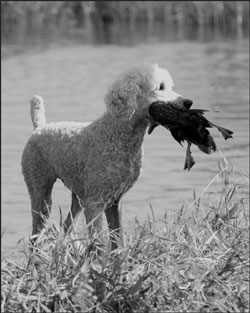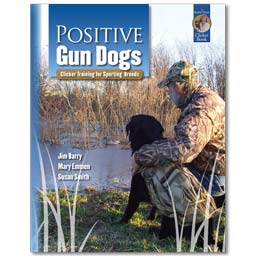Disquieting quiet
It's early morning. Out in the marsh, surrounded by silence, except for the occasional rustle of the reeds and the swish of legs and paws in the water, it's quiet. And yet it's disquieting. At least it is for the close observer of hunting traditions, for we're the only hunting team out here without an electronic remote trainer. And everyone notices.
That's how I imagine it feels for the authors of Positive Gun Dogs: Clicker Training for Sporting Breeds. It's never easy deciding to be very publicly different. When the rest of the country is using electronic collars, you know that saying you can raise a great hunting dog without a single shock is going to attract some less than flattering attention along with the mildly curious questions and heartfelt praise. (See "On Being a Change Maker.")
But that's exactly the trail that the trio of authors behind Positive Gun Dogs (PGD) have decided to travel. So I wanted to travel it with them. I wondered how this new book came to be. Are the authors more excited or afraid? What's the future they see for clicker training in the field of hunting? And why should someone who's been successful using an e-collar even consider trading in his remote for a clicker?
The long and windy road
This is not a nouveau topic. Dogs have assisted humans in hunting for sport since the Middle Ages. People that breed, raise, train, and work with hunting dogs are committed and passionate. The basic practices that have been employed to train hunting dogs are almost as old as the tradition of assisted hunting itself. It's these deep-rooted traditions, lore, and, more recently, the marketing deluge by electronic collar manufacturers that keep the majority of gun dog trainers reliant on practices that involve using force to achieve reliable and fluent behaviors in the field. So for a long time, nothing changed. But neither was anything truly different offered. The gun dog training history road is really one long, no-exit highway leading to the promised town of "trained gun dogs." All along the way, as the road winds through time, you can see the billboards advertising the newest way to train using force.
Of hitchhikers and road builders
Onto this road, like hitchhikers, comes a trio. Two are women. All are travel savvy. They'd rather walk than get in a car they felt was unsafe. They're steeped in the methods of clicker training. Collectively, they're long students of Karen Pryor, Jean Donaldson, Bob Bailey, Morgan Spector, and Carole Peeler. They are internet savvy, too. They comfortable creating community and connections in the ether of discussion lists. They share something else. They like training gun dogs.
The authors meet on the PositiveGunDogs Yahoo Group discussion list, which Susan and Mary founded after recognizing that positive gun dog trainers, like themselves, needed an oasis. Jim was soon an active member, and before long the three trainers began working on Positive Gun Dogs in response to list members' frequent pleas for a well-developed resource—a guide that wouldn't promote coercion and fear as training tools. Before long they've done something that for centuries hasn't been done. They create a true exit off that highway with a well-marked supporting road, to boot. They're no longer hitchhikers. They're a boy- and girl-scout construction crew. But will people take it? Will it lead them to the same town? Will their friends get lost along the way?

Navigating the new trail
While every training specialty has its own challenges, Jim says that in gun dog training there are three specific issues that stand out: "The first is that the tasks are inherently very demanding, both physically and mentally. They may involve working in difficult terrain and nasty weather for long periods of time, searching for game that is hidden in deep cover. Dogs may have to swim long distances, climb banks, and jump fences. And all of this must be done while being attentive to the handler and the goals. The second challenge is that much of the work is done at great distance. In higher level retriever tests, for examples, multiple retrieves at distances of hundreds of yards are not uncommon. Finally, in field work, there are many opportunities for dogs to engage in inherently rewarding behaviors, such as chasing game or following scents that do not coincide with the handler's desires."
Because of these complexities, Jim and his co-authors had to think creatively not only about basic training methods, but also how to organize training and the sequence in which various skills are introduced. And by its early reviews, Positive Gun Dogs succeeds. It presents this essential information clearly and accessibly, with ample illustrations, diagrams, and pictures.
Testing waters, winning titles
It is the authors' hope that this new book will encourage traditional gun dog trainers to test the waters of positive methods. Mary believes that clicker training has a bright future in the field of hunting. "Many people who come through my Good Manners classes with hunting dogs ask about classes for gun dogs using similar methodology. I believe that the market is moving in that direction because so many more people are starting their dogs out that way, and don't want to flip-flop to traditional methods for the hunting skills. I think the sheer economics of it will help clicker training gain ground."
Susan shares Mary's enthusiasm, but adds a stipulation. "As with all traditional areas of training, it will take time to demonstrate that clicker training is an effective means of training animals to the highest level. One problem I foresee is the overall philosophy of clicker trainers. We tend to be training as much for the fun of it as the end goal—serious field competitors, while also training for the fun of it, do keep the main prize in the forefront of their minds. The criticism is that until clicker trained dogs are winning titles, it will not be taken seriously. I feel this is a valid point—what we need are clicker trainers who are highly competitive to go out there and start winning!"
"Some of the gains will come naturally," says Jim, "as clicker trained dogs appear at tests and trials in greater numbers. There is another positive development that will help to spur interest, and that is the organization of a new Gundog Club based in England that provides a new venue for people who want to train gundogs in a systematic and humane manner. The club has a six-level award system that fits very nicely with the clicker training method, and the first several awards can be gained by working with dummies rather than birds. We think that, between the book and the new award system, there is a great potential to draw new participants into field sports because they can now get tangible recognition for their accomplishments using positive training methods and without actually having to hunt or witness birds being hunted, as is currently the case with US tests and trials."
Standing out
Hunting for sport is widely dominated by traditional trainers. Sometimes being the minority all-positive trainer is difficult. "It can be a bit daunting to be the only person at a test with a clicker on his lanyard," says Jim. "On the other hand, the positive gun dog training group is a rapidly growing minority, as evidenced by the fact that there are several hundred members on the PositiveGunDogs discussion list. Clicker trained dogs are beginning to achieve titles in hunt tests and the method is gaining greater acceptance on internet forums, especially those from Great Britain. So we are hopeful that the balance will eventually shift more toward positive methods, as it has in other canine activities."
Susan isn't bothered by standing out. "I don't find it difficult. I believe that philosophies change as society is ready. I feel lucky and privileged to be in the forefront of this movement; however, I understand the resistance traditional trainers have to new methods. After all, they've been successfully training dogs for many years, and don't see the need to change. I believe that the market will dictate methodology. As we become more sophisticated in our understanding of behavior and as our companion animals become more a part of our families, we will want gentler methods."
Comforting quiet
I feel now like I've been down this road, a bit. I can see around the corners, past the big oak and beyond the brush. When I imagine the authors in the reeds now, I don't see them alone. I see them joined by lot of other hunting teams and, to my delight, lots of them are working clicker trained gun dogs in the field. Everyone's having fun and comparing titles.
I like this sport.




Post new comment